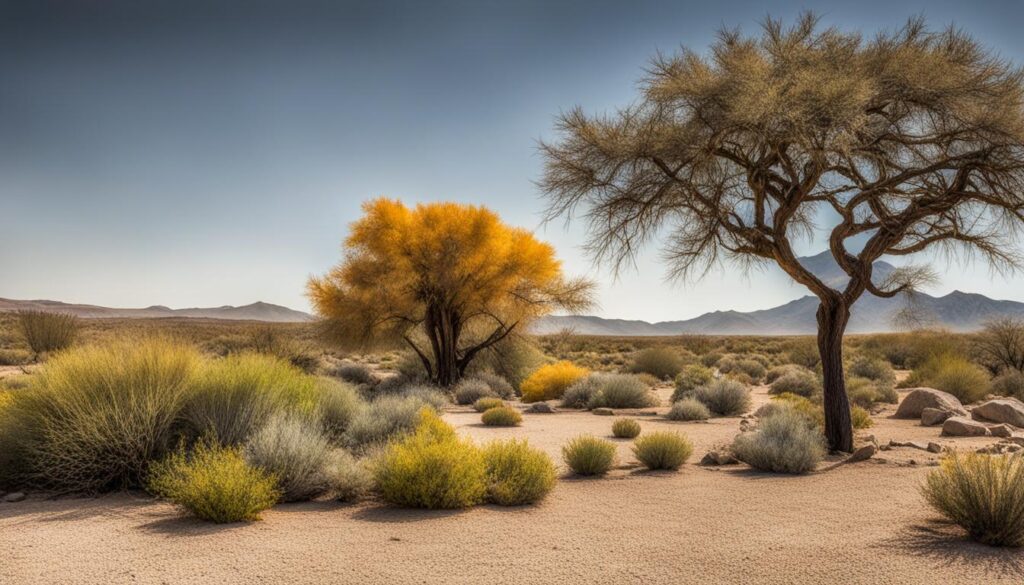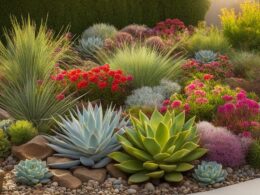Xeriscaping is a sustainable solution for creating beautiful, water-efficient gardens. By implementing water-efficient native plants, you can conserve water, enhance your garden’s resilience, and maintain aesthetic appeal all year round.
Key Takeaways:
- Xeriscaping is a sustainable gardening practice that minimizes water requirements.
- Water-efficient native plants are essential for a xeriscape.
- Xeriscaping helps conserve water, reduce environmental impact, and save on water bills.
- Practical tips like soil preparation, efficient irrigation, and regular maintenance are crucial for a successful xeriscape.
- With xeriscaping, you can create a thriving garden with less water while supporting environmental sustainability.
What is Xeriscaping?
Xeriscaping is a landscaping practice that focuses on minimizing water requirements, making it an ideal solution for water-conscious gardeners. By implementing xeriscaping principles, you can create a beautiful and sustainable landscape while reducing your reliance on supplemental irrigation.
The main principles of xeriscaping include proper soil preparation, careful plant selection, efficient irrigation strategies, and incorporating hardscaping elements. Soil preparation involves testing and improving the soil’s composition to ensure optimal water retention. By selecting water-efficient native plants, you can minimize water usage while maintaining a vibrant garden. Efficient irrigation techniques such as drip irrigation and rainwater harvesting help deliver water directly to the plants’ roots, minimizing wastage. Additionally, incorporating hardscaping elements like gravel pathways or decorative rocks can add visual interest while reducing the area that requires watering.
Xeriscaping not only reduces water requirements but also promotes environmental sustainability. By conserving water, xeriscaping helps protect this precious resource and contributes to the overall health of our ecosystems. Furthermore, xeriscapes often require fewer chemical fertilizers and pesticides, reducing potential harm to the environment. By supporting native plants and wildlife, xeriscaping also enhances biodiversity, creating habitat opportunities for local flora and fauna. Lastly, xeriscaping reduces the carbon footprint associated with traditional gardening by minimizing the use of water-intensive maintenance equipment.
In conclusion, xeriscaping is a landscaping approach that embraces water efficiency and environmental stewardship. By following the principles of xeriscaping, you can create a visually appealing garden while conserving water and minimizing your impact on the planet.
Benefits of Xeriscaping
Xeriscaping offers numerous benefits that make it an attractive choice for homeowners and environmentally conscious gardeners. The key advantages of xeriscaping include water conservation, environmental sustainability, cost savings, and increased property value.
Water Conservation
One of the most significant benefits of xeriscaping is its ability to conserve water. Traditional landscapes often require significant amounts of water to maintain their lush appearance, leading to excessive water consumption. In contrast, xeriscaping can reduce outdoor water usage by up to 75% compared to traditional landscapes.
Environmental Sustainability
Xeriscaping promotes environmental sustainability by reducing the use of chemical fertilizers and pesticides. By selecting native plants that are adapted to the local climate and soil conditions, xeriscaping minimizes the need for synthetic chemicals that can harm the environment. Additionally, xeriscaping supports biodiversity by providing habitats for local wildlife, including birds, butterflies, and beneficial insects.
Cost Savings
Implementing a xeriscape can lead to significant cost savings over time. By reducing water consumption, homeowners can lower their monthly water bills. Moreover, xeriscaping requires less maintenance compared to traditional landscapes, leading to reduced costs for irrigation, mowing, and maintenance equipment.
Increased Property Value
A well-designed xeriscape can enhance the visual appeal of a property, thus increasing its value. Xeriscaped properties are often seen as more attractive and desirable in real estate markets due to their low-maintenance nature, water efficiency, and environmental benefits. Investing in xeriscaping can provide a return on investment by improving the curb appeal and overall value of the property.
Table: Comparison of Xeriscaping Benefits
| Benefits | Xeriscaping | Traditional Landscaping |
|---|---|---|
| Water Conservation | ✓ | ✗ |
| Environmental Sustainability | ✓ | ✗ |
| Cost Savings | ✓ | ✗ |
| Increased Property Value | ✓ | ✗ |
The table above highlights the contrasting benefits of xeriscaping compared to traditional landscaping. While xeriscaping offers water conservation, environmental sustainability, cost savings, and increased property value, traditional landscaping falls short in these areas. By choosing xeriscaping, you can create a beautiful and sustainable garden while enjoying the advantages it brings.
Practical Tips for Xeriscaping
If you’re ready to create a water-efficient and visually appealing xeriscape, here are some practical tips to get you started:
Soil Preparation
Proper soil preparation is crucial for the success of your xeriscape. Begin by testing the composition and pH levels of your soil. This will help you determine which amendments are necessary to create a well-draining soil suitable for water-efficient plants. Add organic matter, such as compost or aged manure, to improve soil structure and nutrient retention. This will support healthy plant growth and ensure efficient water uptake.
Plant Selection
Choosing the right plants is key to a thriving xeriscape. Opt for drought-tolerant native plants that are well-suited to your region’s climate and soil conditions. These plants have adapted to local environmental stressors and require less water to thrive. Group plants with similar water needs together to create efficient irrigation zones. This will help you optimize water usage and prevent overwatering or underwatering specific areas of your garden.
Efficient Irrigation
Efficient irrigation techniques are essential for a water-efficient xeriscape. Consider using drip irrigation systems that deliver water directly to the plant’s root zone, minimizing evaporation and water waste. Rainwater harvesting is another sustainable option to supplement your irrigation needs. Collect rainwater in barrels or cisterns during rainy periods and use it during drier times. This reduces reliance on traditional water sources and conserves precious water resources.
Hardscaping and Mulching
Incorporating hardscaping elements, such as paths, patios, or rock features, can add aesthetic appeal to your xeriscape while reducing the need for water-intensive plants. Mulching is also essential as it helps retain soil moisture, suppresses weed growth, and regulates soil temperature. Apply a layer of organic mulch, such as wood chips or straw, around your plants to conserve water and improve overall plant health.
Maintenance and Monitoring
Regular maintenance and monitoring are crucial to the long-term success of your xeriscape. Remove weeds regularly to prevent competition for water and nutrients. Prune plants as needed to maintain their shape and health. Monitor soil moisture levels and adjust irrigation accordingly, avoiding both overwatering and underwatering. By staying attentive to the needs of your xeriscape, you can ensure its continued beauty and water efficiency.
| Xeriscaping Tips | Benefits |
|---|---|
| Proper soil preparation | Improves drainage and nutrient retention |
| Choose drought-tolerant native plants | Reduces water requirements, supports local ecosystem |
| Use efficient irrigation techniques | Minimizes water waste, conserves resources |
| Incorporate hardscaping elements and mulch | Adds visual appeal, reduces water-intensive areas |
| Maintain and monitor your xeriscape | Promotes long-term health and water efficiency |
A Thriving Garden with Less Water
Xeriscaping allows for the creation of a thriving garden with less water. By implementing practical techniques such as choosing drought-resistant plants, applying mulch, utilizing efficient irrigation methods, and grouping plants based on their water needs, you can create a visually stunning and sustainable landscape even in water-scarce conditions.
Drought-resistant plants are a key component of a successful xeriscape. These plants have evolved to survive in arid climates and require less water than traditional garden plants. They are often characterized by their deep root systems, waxy leaves, and other adaptations that allow them to conserve water. By incorporating drought-resistant plants into your xeriscape, you can reduce your water consumption and still enjoy a beautiful garden.
Another important technique in xeriscaping is mulching. Applying mulch around your plants helps to retain moisture in the soil, prevent weed growth, and regulate soil temperature. Organic materials such as wood chips, straw, or compost can be used as mulch, providing additional benefits such as enriching the soil and reducing the need for chemical fertilizers. Mulching is a simple yet effective way to conserve water and promote the health of your xeriscape.
Efficient irrigation is crucial in xeriscaping to minimize water waste. Drip irrigation systems, which deliver water directly to the roots of plants, are highly efficient and reduce evaporation. Rainwater harvesting, another technique to consider, involves collecting and storing rainwater for later use in your garden. By using these irrigation methods, you can ensure that water is distributed precisely to where it is needed, optimizing water use and promoting the sustainability of your xeriscape.
Environmental Benefits of Xeriscaping
Xeriscaping not only helps conserve water but also offers numerous environmental benefits. By adopting water-efficient native plants and implementing sustainable gardening practices, you can contribute to a healthier ecosystem and reduce your carbon footprint.
Promoting Water Conservation
One of the primary advantages of xeriscaping is its significant contribution to water conservation. By selecting drought-tolerant plants that require minimal watering, you can drastically reduce your outdoor water usage. This not only helps preserve precious water resources but also minimizes the strain on local water supplies during droughts and water scarcity situations.
Decreased Use of Chemical Fertilizers and Pesticides
Xeriscaping encourages the decreased use of chemical fertilizers and pesticides, which can have harmful effects on the environment. By relying on native plants that are well-adapted to the local climate and soil conditions, you can reduce the need for chemical interventions. This helps maintain a healthier balance in the ecosystem, promoting pollination by native insects and improving soil health.
Enhanced Biodiversity
When you choose water-efficient native plants for your xeriscape, you create a habitat that supports local wildlife and enhances biodiversity. Native plants provide food and shelter for birds, butterflies, and other beneficial insects. By supporting the local ecosystem, you foster a more sustainable environment and foster a sense of harmony with nature.
Lower Carbon Footprint
Xeriscaping can also contribute to a lower carbon footprint. By reducing water consumption and minimizing the use of fossil fuel-powered maintenance equipment, such as gas-powered lawnmowers, you can help mitigate climate change. The use of sustainable gardening practices aligns with a greener lifestyle and supports efforts to reduce greenhouse gas emissions.
| Environmental Benefits of Xeriscaping | |
|---|---|
| Water Conservation | Drastically reduces outdoor water usage and strain on local water supplies. |
| Decreased Use of Chemical Fertilizers and Pesticides | Reduces dependence on harmful chemicals and promotes a healthier ecosystem. |
| Enhanced Biodiversity | Creates a habitat that supports local wildlife and promotes biodiversity. |
| Lower Carbon Footprint | Reduces water consumption and minimizes the use of fossil fuel-powered equipment. |
What Are the Best Water-Efficient Native Plants for Xeriscaping?
When considering native plant xeriscape maintenance, it’s important to choose water-efficient options. Some of the best choices for xeriscaping include lavender, yarrow, and desert marigold. These native plants require minimal water once established and can thrive in arid environments with little maintenance.
Conclusion
Xeriscaping with water-efficient native plants is a practical and sustainable approach to gardening. By implementing these techniques, you can create a visually appealing and resilient landscape while conserving water and minimizing environmental impact.
By following the principles and tips of xeriscaping, you can transform your dry landscape into a thriving, water-efficient garden that enhances the beauty of your property. Not only will you reduce your water consumption, but you will also contribute to a greener future.
With xeriscaping, you can enjoy the benefits of a lush garden without the guilt of excessive water usage. Embrace the use of drought-tolerant native plants, efficient irrigation techniques like drip irrigation, and proper soil preparation to maximize your garden’s water efficiency.
By adopting sustainable gardening practices like xeriscaping, you are not only creating a beautiful and low-maintenance landscape but also contributing to the preservation of precious water resources and supporting a healthier ecosystem. Start xeriscaping today and watch your garden thrive while making a positive impact on the environment.











